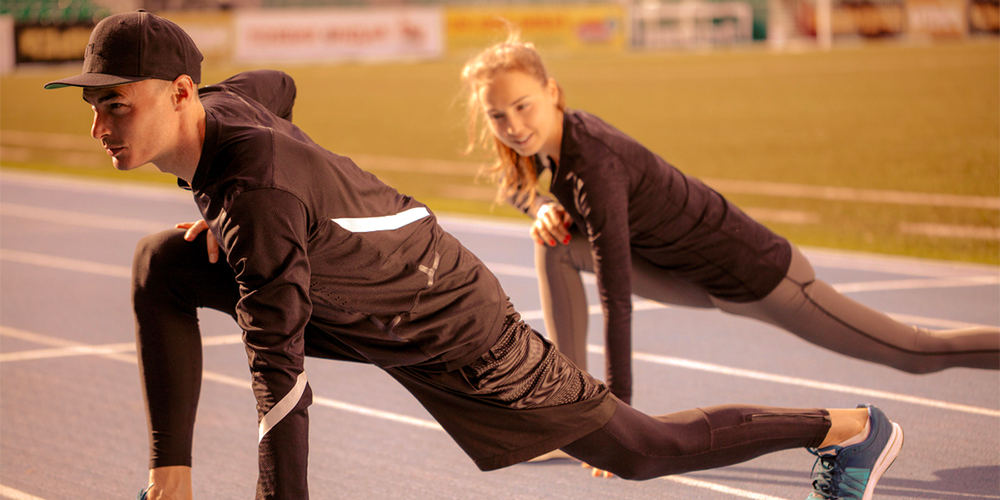Beginning runners in particular benefit from mobility and flexibility training. Regular stretching exercises increase performance, promote regeneration and prevent muscular imbalances.
Author: Franz Lauener, M.D., Rheumatic Diseases, Interventional Pain Therapy, Sports Medicine, Manual Medicine Swiss Olympic Medical Center/ Club Doctor HCD, Co-Head Medbase Abtwil
Avoiding muscular imbalances – that’s why you should stretch
When runners don’t feel as good as they used to, or when they cramp just climbing stairs, it’s time to train flexibility.
After all, those who run regularly use certain muscles in particular: The hip flexors, the “hamstrings” on the backs of the thighs, the knee extensors and the calf muscles. These muscles become stronger and harder through constant use. Their counterparts, on the other hand, which are little used in comparison, shorten more and more without special care. This creates muscular imbalances – which in turn makes you more susceptible to injury.
Mobility training 2-3 times a week
Regular flexibility training, i.e. two to three times a week, helps to avoid such muscular imbalances. On the Internet you can find a variety of websites and videos that show which exercises are suitable for this.
When stretching, we often forget about the fascia on the sole of the foot. Roll the foot slowly forwards and backwards over a can/box. Or stand with the balls of your feet on a step and gently stretch the plantar fascia.
If done well, stretching serves several purposes: it helps to maintain health, increases performance and promotes regeneration after exercise. Because unfamiliar, new stresses are more likely to cause injury, mobility training is especially important for beginning runners.
Create with running.COACH a customized and dynamic running training plan that optimally prepares you for your running goals based on your current fitness level. Try running.COACH for free for two weeks after your first login!
Two stretching techniques
Sports physicians distinguish between two different stretching techniques: static posture exercises and dynamic swing exercises. If you have no experience, it is better to leave the dynamic exercises. Otherwise, there is a high risk of muscle damage or strain.
What should be observed?
Static stretching exercises involve staying in the same position for 15 to 30 seconds. This may be a bit uncomfortable, but it should not hurt. Abrupt, jerky movements should be avoided and are counterproductive.
To move through all the muscle groups in this way, you need to allow ten to fifteen minutes. The answer is immediately noticeable: both during and after flexibility training, you should feel good. A fascia roller can be supportive (fascia training for runners), but therabands are not suitable for mobility training because they give resistance (“force-acting”).
Flexibility varies greatly from person to person; it decreases with age – but can also be improved again with appropriate training. It is important to listen to the signals of your own body during stretching exercises, to feel its limits – and to respect them. There is no point in forcibly overriding resistance or setting a goal that you absolutely want to achieve when stretching. That will only result in injury.
Stretching after running – yes or no?
The same applies to stretching immediately after a competition or after a very strenuous workout. The muscles are already fatigued. Stretching them in this situation quickly leads to muscle fiber injury. After a light workout, on the other hand, there is nothing to stop you from stretching.
Existing back or joint problems should also be taken into account. If a joint does not feel good after stretching, something must have gone wrong with the mobility training.
A misconception many runners make is that stretching per se reduces injuries. The best measure to reduce running injuries remains warming up before running. Stretching does not replace the warm-up!
Tips
- Agility can be improved at any age – but always watch your limits!
- Perform stretching exercises only when warmed up.
- Regular flexibility training is important: If you want to make shortened muscles “longer”, you should stretch them daily.
- Mobility training also involves good perception of the body: develop a feeling for the optimal stretching stimulus!
- If stretching is also intended to help you relax after exercise, it is helpful if done lying down or sitting down and in a quiet atmosphere.
You can also find a lot of input on flexibility training in the logged-in area of running.COACH.
Who is Medbase?
Medbase is the largest multidisciplinary sports medicine network in Switzerland and provides specialised sports medicine services for athletes, clubs and sports federations of all activity levels in the areas of sports medicine, sports physiotherapy, performance diagnostics and training advice.




